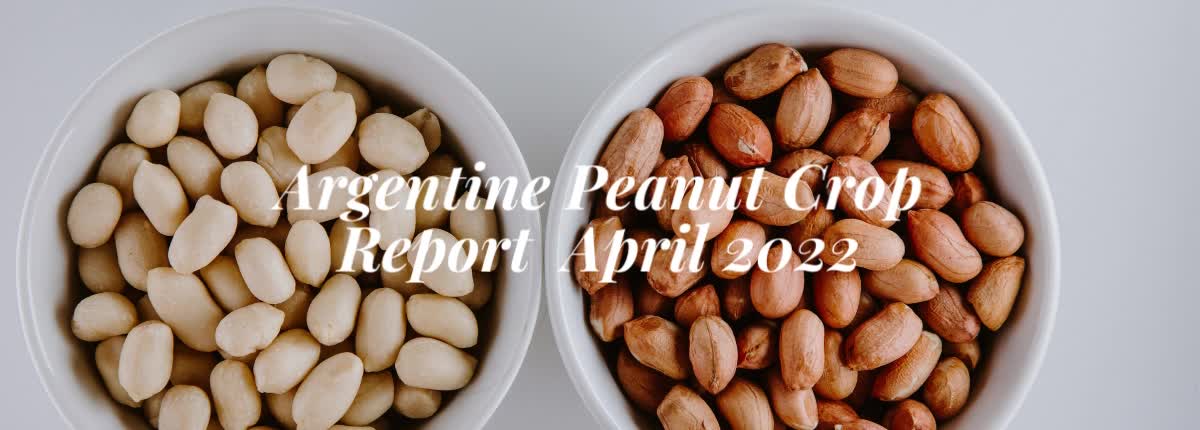
Overview
As we move towards the end of the peanut cycle and the start of the digging and harvesting season, the present condition of the peanut crop is good for most of the planted area. Overall, the prevailing weather conditions are the ones stated in the previous edition of this report. Rainfalls have been less than expected for most of the peanut-growing area. Isolated light showers were reported mainly in the Southern and Eastern areas. Presently, the Central and Northern areas are the most severely affected by drought. Late March (29-31) faced a polar air spell from the south, which lowered temperatures substantially to -0 °C, causing frost in most of the peanut area. Frost inflicted considerable damage on peanut crops, since their physiological maturity stage was insufficient to allow digging (PM <30%). On such grounds, and according to our reference map, we may distinguish different areas according to the impact of frost:
• Southern and Western Area: severe.
• Central-Southern Area: very severe.
• Eastern and Central Area: regular.
• Northern Area: mild.
An important and determining factor worth considering in the face of such meteorological events is the number of hours crops face exposure to low temperatures. The more exposure to the cold, the greater the cellular destruction in the plant. It is worth highlighting that since peanut crops have not reached their optimal physiological maturity (PM) percentage, they are undergoing the beginning seed stage; consequently, final yields could be severely impacted, not only by low temperatures, but also by the duration of the meteorological event.
In this context, we may refer to clearly distinct situations: the Western and Southern areas (southwest of Córdoba, San Luis and a part of the province of Buenos Aires) are the most seriously affected regarding plant development (% PM). Yield forecasts are very dissimilar for these areas, but we believe they will not exceed average yields. On the other hand, the Central-Southern, Northern and Eastern areas face a more promising outlook and better yields, as expected. The Central area features the worst productive scenario, with yields that are significantly below average. It is worth noting that field conditions in the same area may differ significantly from each other, due to the different rainfall levels and the available water content in the soil.
The following chart features the overall crop condition, as determined by our professional criterion.

The crop is evolving in line with the descriptions in previous reports. This is a highly heterogeneous year and it becomes difficult to estimate yields accurately. Anyhow, to the best of our knowledge, we believe that yields for this season will drop to 3 tons/h of inshell peanuts. Considering yields from the last few seasons, we estimate lower productivity. The main causes for this loss are the unfavorable weather conditions that prevailed throughout this season.
Unlike the previous season, when physiological maturity at this point in time had reached 60%, this year poses a completely different scenario with physiological maturity at approximately 30/35%.
In regards to plant disease and pests, fungicide applications have been made for the third time to prevent peanut leafspot, and control isolated foci of red spider mite. S. Sclerotiorum continues developing in many fields and has reached concerning incidence levels.
The crop in general is going through the full seed phenological stage (R6 reproductive stage). This stage is critical since it defines crop yields.
As this report is being drafted, digging tasks have started in the fields that face soil disease, such as S. Sclerotiorum. We expect digging tasks to be carried out extensively in the forthcoming 10/15 days, during the second half of April.
Gastaldi Reference Map of Peanut Areas
The main peanut areas in Argentina include the provinces of Córdoba, La Pampa, San Luis and Buenos Aires.

Rainfall and temperature analysis
As previously mentioned, rainfall was scarce during March. Overall, the departments of San Javier, Gral. Roca, Río Segundo, Río Cuarto, Tercero Arriba and San Martín evidence a negative rainfall balance compared with historical averages for such areas. Present records are well below average, which makes them the most affected and underdeveloped areas. Clearly, crops will suffer a substantial delay in their evolution compared with the remaining areas. Peanuts feature mild water stress.
Nonetheless, it is worth highlighting that certain fields located mainly in the Eastern, Southern and Northern areas benefited from isolated showers that helped mitigate the water demand of peanuts. In this case, the available water content was higher and this mitigated the absence of rain in previous months.
Specifically in the Northern area, fields were planted later and water demand was not as high as in the other areas, where the crop is in full reproductive development.
The following BCCBA map depicts monthly accumulated rainfall in the province of Córdoba during March:

March temperatures featured values below the historical average as per statistics for the area. Average lows ranged at 13 °C, while average highs ranged between 25 °C and 27 °C. (Source: SMN, National Weather Service, as per the Spanish acronym). As stated above, between 30-31 March and 1 April the areas faced an unusual meteorological event for the time of year. A cold front from the south brought frost and temperatures below zero. This phenomenon continues for the third consecutive day across the whole province and in neighboring provinces: west of San Luis, northeast of La Pampa and northeast and southeast of Buenos Aires.

Number of Hours of Agronomic Frost Exposure



Available Water Content in Córdoba
Soil moisture may reach its maximum retention capacity or field capacity (by which plants extract water without difficulty). Between field capacity and the permanent wilting point stands the range that we designate Useful Water
The map depicts that in early April, values in the peanut-growing area stand at 5% in the Northern Area, 5% in the Central area, >5% in the Western Area and 35% in the Eastern and Southern area, indicative of temporary drought.


Available Water Content in Argentina as of 1 March 2022 vs. 1 April 2022
As featured on the maps, the situation had a negative turn from one month to the next. This situation could be fully reversed with new rainfalls in the peanut-growing area in the forthcoming days.
Field tasks
Due to the prevailing hydric stress, insecticide applications were reinforced to control mites. In many cases, farmers applied more than three doses due to the high incidence of this pest.
Additionally, S. Sclerotiorum incidence is progressing at alarming levels. Estimations indicate that numerous peanut lots from different areas will require digging before completing their phenological cycle due to this soil disease. We are closely monitoring disease progression to adopt the appropriate measures to minimize losses. It is worth noting that there is no treatment to stop disease progression, and once it affects the crop, it is impossible to eradicate.
On the other hand, second and third preventive fungicide applications were completed to control peanut leafspot.



Phenological Crop Evolution
By Area

General

Peanut Development Stages
| V1: first tetrafoliolate leaf V2: second tetrafoliolate leaf V3: third tetrafoliolate leaf V4: fourth tetrafoliolate leaf V – (N): one to N developed nodes on main axis | R1: beginning bloom R2: beginning peg R3: beginning pod R4: full pod R5: beginning seed R6: full seed R7: beginning maturity R8: harvest maturity |
Conclusions
The peanut crop is in good condition as of today and remains a good project, although yield expectations could drop should low temperatures continue. We should consider that the frost of the past weeks has caused severe damage and we are still unable to quantify the actual kg/h reduction. Losses include quantity and quality.
The outlook for yield losses is especially concerning for the area where leaf development and physiological maturity were limited. Nonetheless, as stated above, yield outlooks for the Eastern and Central-Southern areas and part of the Southern area will exceed those of the other areas. This is due to greater rainfall during the season and higher available water content in their soil, which allowed for better development.
Presently, peanuts are going through the phenological stages of the advanced reproductive stages, which on average stand at an advanced R6 (full seed) stage.
We assess the 21/22 harvest as very heterogeneous and with an estimated yield of 3 tons/hectare of inshell peanuts.
Digging is one of the most important tasks that may directly impact crop yield. Consequently, it will be important to rely on favorable weather and soil conditions to perform this task in the fields. As always, we stay attentive to short and mid-term weather forecasts, particularly at this time, in order to determine the optimal window to start digging and harvesting tasks.







We will be present at the IPF in Budapest. In case you wish to make an appointment please contact us and we will be glad to set a meeting.
Do you have a commercial inquiry?
Other questions or comments?


